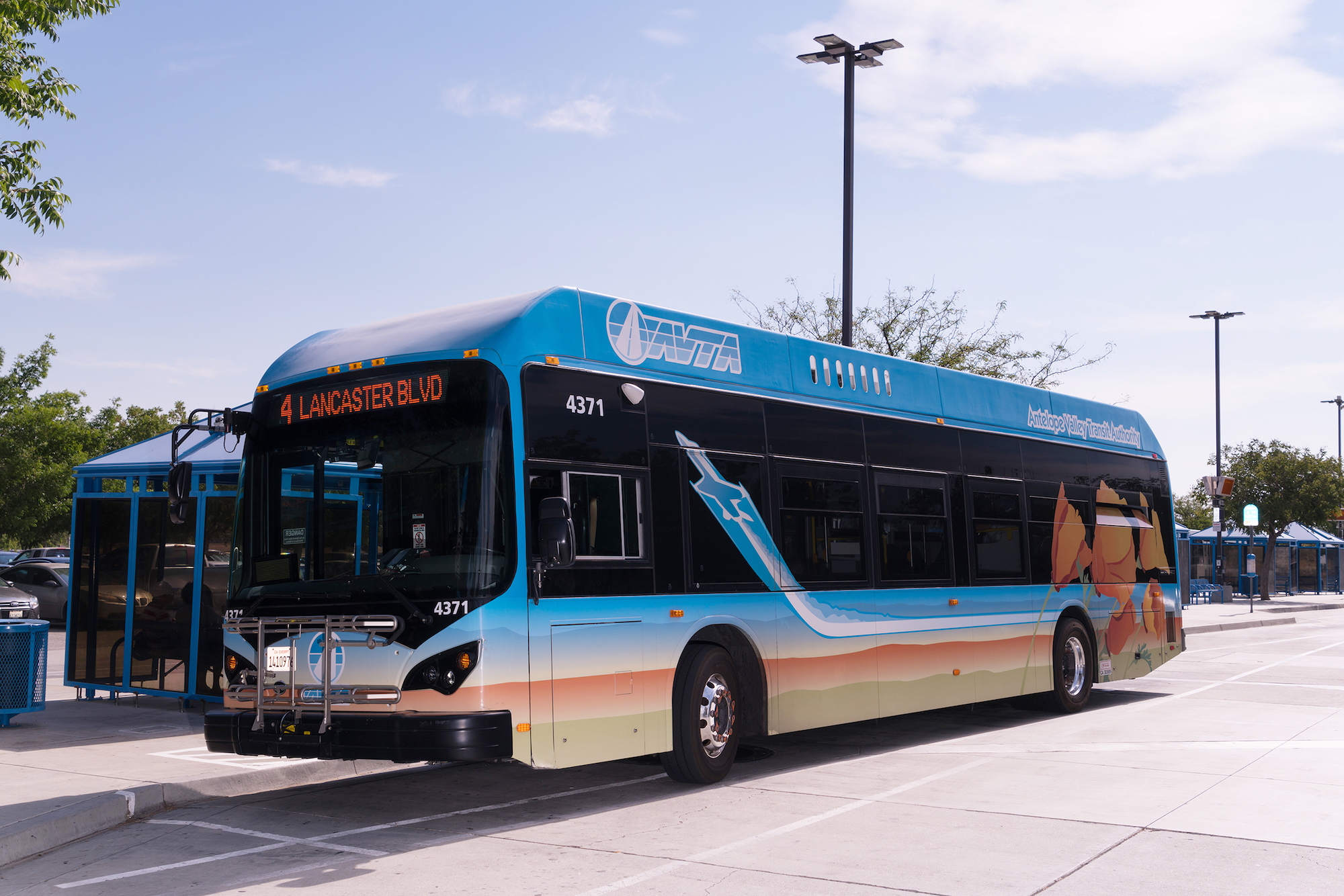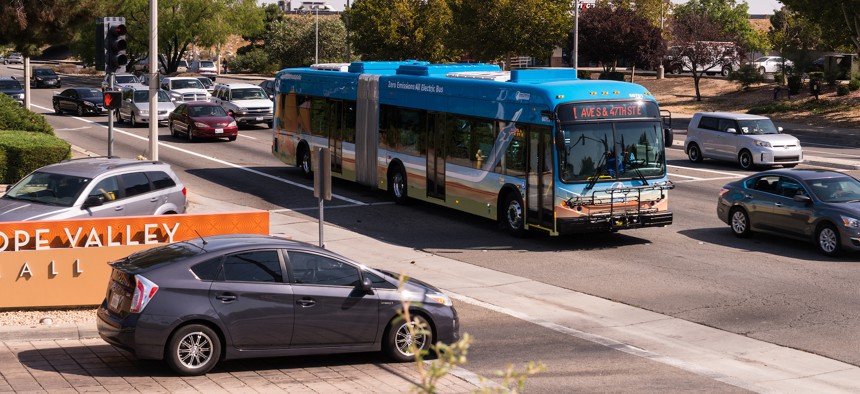Connecting state and local government leaders
They’re cheaper to run compared to ones with internal combustion engines thanks to the economics of fuel and maintenance.
As more and more transit agencies around the world, from London to Los Angeles, convert to electric-powered bus fleets, the industry has been able to move past stubborn design uncertainties that a few years ago clouded its future.
Large, onboard batteries and questions over range capability were seen as major challenges to overcome. But new design improvements—and cheaper batteries—are making them an increasingly affordable option.
By the year 2025, Bloomberg New Energy Finance expects that half of the world’s municipal bus fleet will be electric, a turnover rate far quicker than what is being predicted for passenger cars. Unlike in that market, the purchasing power of public transit agencies and unique economics of electric vehicle running costs make bus fleets easier to convert. Although Albuquerque officials have run into trouble with the delivery of new electric buses for the city’s forthcoming bus rapid transit line, the EV industry has largely been able to overcome earlier skepticism about the range capabilities and reliability of the heavy-weight vehicles.
Take the Antelope Valley Transit Authority in Southern California, which serves the high desert communities of Lancaster, Palmdale, Sun Valley and Pearblossom. Nearly five years ago, the authority began to convert its diesel bus fleet to 40-foot EVs. The AVTA is now running 10 electric buses, including some 60-foot articulated vehicles, and officials hope to have all 80 buses in the fleet converted by the end of the year.
“That will make us the first 100 percent battery-electric-vehicle transit agency in the country,” said CEO Len Engel.
Electric buses, like electric cars, have faced an ongoing adoption hurdle as their sticker price is in most cases higher, if not significantly higher, than a petrol-powered vehicle. While the AVTA has been sourcing EV buses in stages, one sample price comparison for the 40-foot model in 2015 showed that a typical diesel bus cost $445,000 while an EV bus of similar length came in at $770,000, according to figures supplied by AVTA.
But the lower running costs of the electric buses, thanks to the economics of fuel and maintenance makes them cheaper to operate compared to ones with internal combustion engines. That’s proving to be attractive to transit agencies, which can absorb the upfront capital expenses more easily than an individual consumer thinking about buying an EV.
For its part, AVTA was able to tap $50 million in grants from California’s Transit and Intercity Rail Capital Program. “The state was a boon for us, and we were the only agency funded through all three cycles of that program,” Engel said.
But the transit authority also had a unique advantage. A major manufacturer of EV buses, China’s BYD, set up shop in Lancaster in 2013. When AVTA started to explore electrification, therefore, the solution looked like a double-bottom line win for Antelope Valley: an increase in local jobs and the ability to source a new fleet at a competitive price.
“The last thing BYD wanted was to have an EV bus made by another company running here, in front of their facility,” said Engel. “As a result, we were handed very favorable price terms.”
Global Bus Boom
Electric buses appear to be following a familiar path of technological change seen in computers, mobile phones, and wind and solar power, as growing adoption increases manufacturing output, steadily driving costs downward. Of late, this can best be seen in China.
Starting in 2012, the Chinese city of Shenzhen began to electrify its bus fleet, converting less than 300 of its municipal fleet. Five years later, the city completed its transition, with over 16,000 EV buses by the end of 2017, according to data from World Resources Institute, using Shenzhen transport agency figures. Just as China’s demand for wind and solar power have driven down costs, its astonishing deployment of EV buses is doing the same. According to Bloomberg New Energy Finance data recently released in its Electric Vehicle Outlook 2018, total cost of ownership of EV buses has started to compete directly with traditional diesel buses, on a dollars-per-distance measure. BNEF also notes that the higher upfront sticker price still presents a hurdle.
Major transit agencies across this country are joining the trend. The New York Metropolitan Transportation Authority intends to convert its fleet by 2040. Los Angeles Metro, striking a contract with another California-located manufacturer, Proterra, plans to do the same, but on a more aggressive timeline by the year 2030. In the Seattle area, King County Metro trialed buses from different suppliers, and in early 2017 struck the largest order in the U.S. from Proterra. Los Angeles followed later in the year, completing an even larger contract, with BYD. Outside the U.S., London is already taking delivery of new EV buses, as other U.K. cities including Nottingham and Liverpool.
China's BYD, which stands for Build Your Dreams, began its corporate life as a manufacturer of batteries, and the steady price declines of the battery itself is the major factor electric buses’ emerging cost advantage.
Transit companies are also able to rely on electric buses because of the nature of their business. With fixed routes, transit planners can figure out ahead of time if a bus’ battery life will be sufficient for its daily trips.
Engel told Route Fifty that the early 40-foot models had a range of 155 miles, more than enough to handle their routes. AVTA has 12 routes, only one of which is an extended, long route. The new 60-foot, articulated models will have a range of 200 miles, “and the newest 40-footers will have a third generation battery, increasing range beyond the current 155 miles,” Engel said.

Charging Into the Future
In their adoption of EV for public transit, AVTA has also embraced the newest charging technology, with two inductive charging stations, and several more to come. These 50 kW stations are fixed flat pads that allow an electric bus, having rolled into position above them, to charge wirelessly.
A typical bus takes about 4 hours to charge, Engel said, and the AVTA fleet tends to charge these buses overnight. But the strategic placement of the inductive charging stations, as they are unobtrusive and friction free, potentially enhance the fleet’s range capacity, and provide flexibility to the system.
The adoption of this technology also highlights the full systemic changeover taking place at the AVTA and other municipal agencies. This is a total transition not only to new equipment, but to a new supply line system that turns its back on oil and plugs in fully to the power grid. By doing so, AVTA has pivoted to California’s electricity system, which itself is under rapid transformation. Wind and solar power provided a full 20 percent of the state’s electricity last year, and, according to Engel, AVTA works directly with local utilities. As the U.S. Department of Energy’s Argonne Lab, showed in recent analysis, any EV hitting the road in California is automatically cleaner, disproportionally running on a higher mix of wind and solar power, compared to EVs in the rest of the country.
Putting all the numbers together, EV buses globally are pricing at about a 50 percent premium to their diesel counterparts, roughly in the $250,000 range, compared to a baseline roughly at $500,000.
Engel said his agency expects to save at least $1 million per year on a base of 80 vehicles, which themselves roughly cost $15 to 20 million more than a diesel fleet. If you run the total fuel and maintenance savings over, say 15 years, the total comes close to matching the price premium. Transit agencies that follow could enjoy a better match between the premium paid for an EV bus fleet, and the lifetime cost savings.
Of course, another benefit of electric buses can come from avoiding the air pollution associated with diesel. The high desert region of Antelope Valley is beset by secondary pollution that blows north from the Los Angeles basin. Governed by its own California Air Quality Management District, the AVAQMD, the area keeps an eye on asthma rates, which are the plague of children, especially across the state’s great Central Valley.
Upticks in gasoline prices can also help justify the switch to electric. For example, it’s already the case that an EV has at least 50 percent lower fuel costs than a diesel counterpart, and more routinely those savings reach towards 75 percent.
With the price of oil currently back on the march, Route Fifty asked Engel what AVTA planned to do with its existing diesel bus fleet. “We’re actually giving them all away,” he said. “There’s some accounting math that goes along with that, having to do with credits and so forth, but it really is the best thing to do.”
Gregor Macdonald is a journalist based in Portland, Oregon and has written for Next City, Talking Points Memo and The Petroleum Economist.

NEXT STORY: High-tech lie detection



